A Four-Digit Clock Counting From 9999 Down To 0000
2015
At YYZ Artist’s Outlet in Toronto
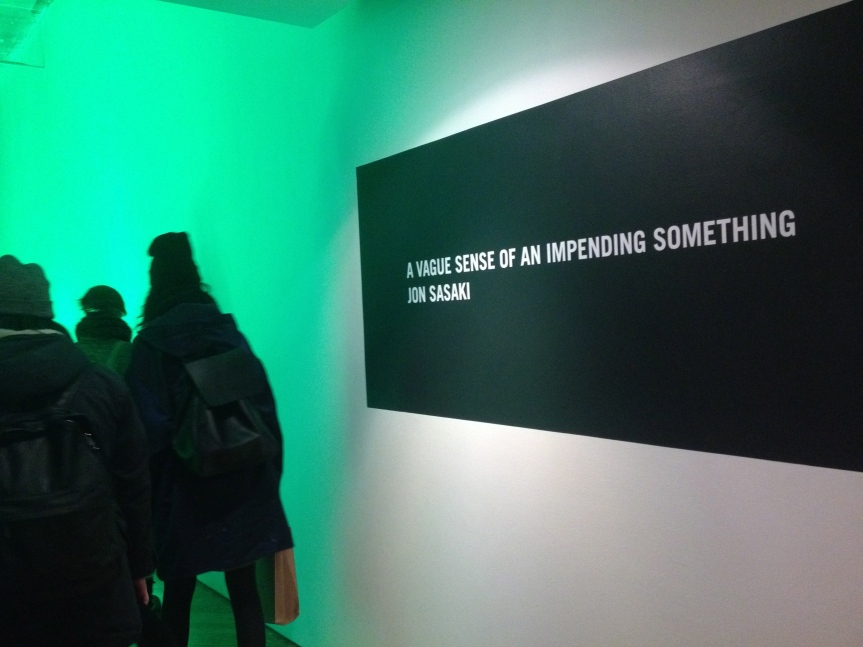

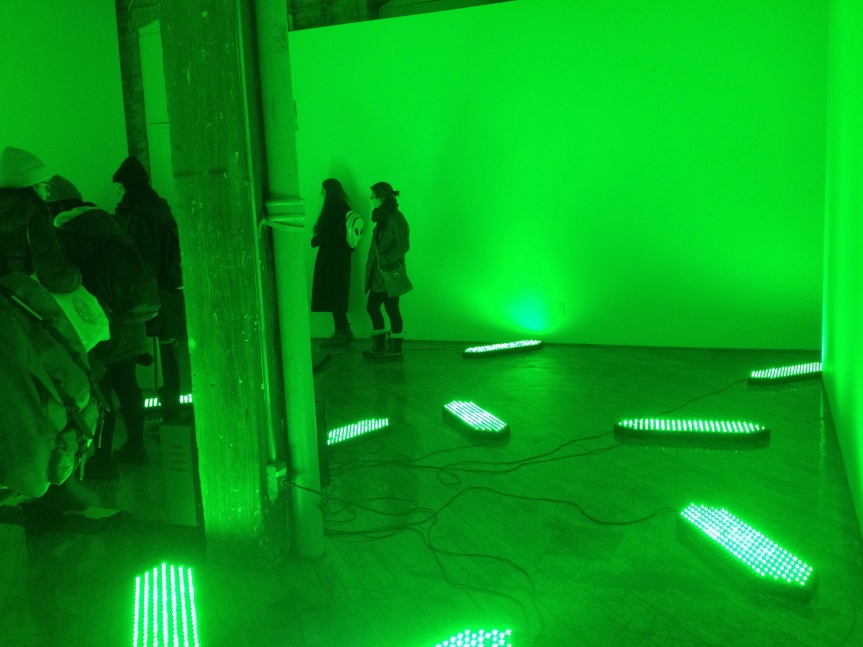

Accompanied by the video Dead End, Eastern Market, Detroit
2015
“In Detroit’s rapidly-gentrifying Eastern Market neighbourhood, a white van approaches the fenced-off dead end of an alleyway, before beginning a laborious, tense and exhausting process of course correction.”
Bio
John Sasaki received a BFA from Mount Allison University in 1996.
He was an active member of Toronto/Vancouver–based collective Instant Coffee from 2002 to 2007.
He lives and works in Toronto and is represented by Jessica Bradley Art + Projects.
And often visits Guelph for artist talks!
Party Art
Napkins (Materials Safety Data Sheet)
2011, Multiple, paper serviettes printed with one of three colours of ink. 5″ x 5″



A Machine To Release One Burst Of Confetti Gradually Over The Duration Of An Exhibition
2011, confetti, motorized conveyer belt, scaffold, stanchions.
These images were taken at Papier Montreal Contemporary Art Fair, April 2015.


“A conveyer belt topped with confetti is programmed to run imperceptibly slowly. At a rate of roughly one flake every five minutes or so, the confetti trickles to the ground, with the entire ‘burst’ piling up on the floor two months later. An exuberant moment is drawn out to absurd lengths, leaving us to question whether or not such gestures of enthusiasm can sustain themselves over time.”
Stop At Nothing
2013, intervention as part of the Parkdale Film & Video Showcase, programme of video works installed in storefront windows.
“I had hoped to upstage the other artists in the Parkdale Film & Video Showcase with an ambitious, highly memorable project. Unfortunately the project didn’t pan out.
So I decided that the next best thing would be to sabotage all the other video installations instead.
Throughout the weekend, I attempted to covertly turn off each window video monitor in the show using a universal remote control, in the hopes that the other artists who did manage to make memorable work would not be remembered either.”

I Wish I Could See The World The Way You Saw The World
2011, installation, monochromatic light fixture, four colourfield paintings from the Kenderdine Art Gallery collection. (works by Herbert Bayer, Yves Gaucher, Gary Lee-Nova, Douglas Morton.)
“Works from the Kenderdine collection were selected for their zeitgeist, possessing the sort of optimism and assuredness often seen in work of the 1960s. Installed under a light fixture that emits only one wavelength, colour relationships were stripped away from these once-vibrant canvases, rendering them grey and depleted. Once faded, they became something of a quiet lament for a more hopeful, bygone era.”


A Machine to Replicate the Effect of a Breeze Through an Open Window.
2012, Air compressor pump, motor, plexi enclosure, electrical components, 100′ hose, inline filters, aluminum square bar. Dimensions variable. Installation view: Gallery 101, Ottawa.


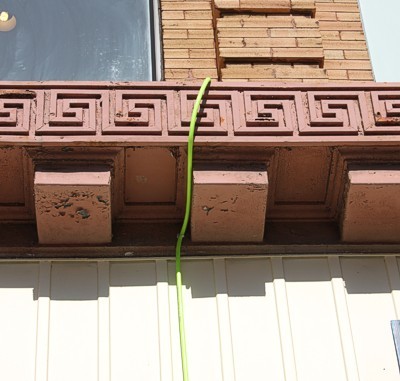
Black Light Thrift Store
2007, Salvation Army Thrift Store in downtown Toronto
An example of how you can transform a preexisting space into an art exhibition space for a short duration of time using a minimal gesture.
“The store’s regular lighting fixtures were replaced with CSI-style ultraviolet lights, directing attention toward the residue of previous owners. The gesture brought to the forefront all the lint, bodily fluids, spills and stains covering the used garments, invisible under normal lighting.”

Nuit Blanche
I Promise It Will Always Be This Way
An all-night performance for Scotiabank Nuit Blanche 2008, Saturday, October 4, 7PM until 7AM Sunday morning. Lamport Stadium, Toronto.
“For “I Promise It Will Always Be This Way” twenty-six costumed team mascots took the field at Lamport Stadium, with instructions to whip the crowd into a fervent frenzy. Throughout the twelve-hour endurance piece, they pulled out all the stops with their mascot antics, while “Jock Rock” sports anthems played over the loudspeakers. As the night progressed and physical fatigue began to set in, the mascots required cigarettes, naps, snacks and bathroom breaks. Plush heads were removed and mascot illusions were broken, revealing the performers to be human after all…capable of feeling cold and weary. However, flying in the face of all expectations, the mascots’ morale never dwindled. An unbelievably supportive, ever-cheering, crowd reciprocated the enthusiasm, creating a touchingly symbiotic back-and-forth of support. What was intended to be a much darker, more futile picture of misspent energy ended up being a very moving moment of social generosity.”
Simple Gestures
His work often focuses on the failure of objects, the failure of people, the failure of ideas.
His work presents small disappointments, playfully addressing the futility of life and art.
A North American Bulb in a 220V Socket
2010, HDV, 0’35”, looped
A 120V lightbulb has been transported from Canada to Ireland, and installed in an incompatible socket. The bulb illuminates very brightly for an instant, only to burn out immediately after.
Ladder Climb
2006, HD video, 1:50, looped.
“The artist’s fairly unsuccessful attempts at climbing an unsupported ladder. Exhibited as a single channel endless loop, the piece suggests both the desire for self-improvement, and the futility of the task.”
In a real dark night of the soul it is always three o’clock in the morning
A multiple for Nothing Else Press, Toronto.
Wired LCD screen, copper & zinc electrodes
9 x 6 x 3 cm.
Edition of 50 signed and numbered copies
“[The buyer] becomes complicit: they have to stab these two potatoes and watch the system run itself down. It’s tragedy, but really only tragicomedy. If it were a sentient being it would be tragedy. It’s comedy because it’s just a potato. There’s something heartbreaking and funny about empathizing with an inanimate object.” Excerpt from an article by Adam Lauder, Canadian Art Magazine, Summer 2014.


(four months later)
Performative Institutional Critique
Performance to Double the MOCCA’s Visitor Figures
2014, ongoing throughout the exhibition “TBD” at the Museum of Contemporary Canadian Art, September 6 – October 26, 2014.
“The MoCCA, like most galleries, makes a very accurate count of the number of daily visitors who stop by, and these figures are subsequently reported by the museum to their various stakeholders.
As a service provided to the institution, I have pledged to singlehandedly double the attendance for this exhibition.”
“By literally “running in circles” for a number of hours each week, I will match the thousands of attendees for this show, eventually culminating in a figure that can be cited in the MoCCA’s year-end reports.”
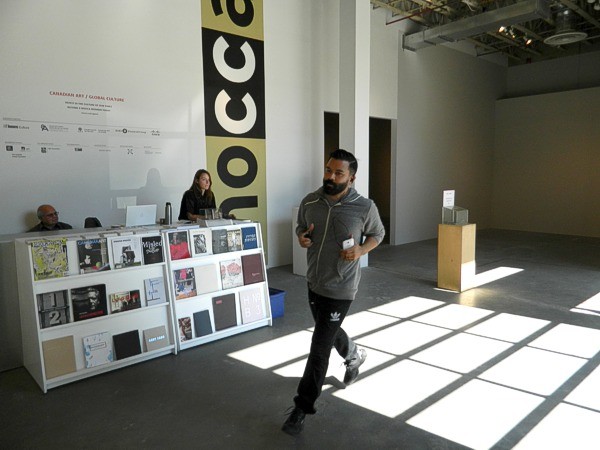

Subverting Common Language
A Clock Set to 24 Hours Into The Future
2014-2015, public artwork for Sheridan College’s Temporary Contemporary, Trafalgar Campus, Oakville Ontario.
“Unlike most campus clocks, this one has been set 24 hours fast, always displaying “tomorrow’s time.” Of course, on a four-numeral digital clock, tomorrow’s time appears indistinguishable from “today’s time,” and therein lies a small bit of levity that is intended to open up a range of poetic interpretations.”
“A clock tower running 24 hours fast is in fact practical and functional in the present, but serves also as an aspirational signpost pointing towards the idea of tomorrow.”
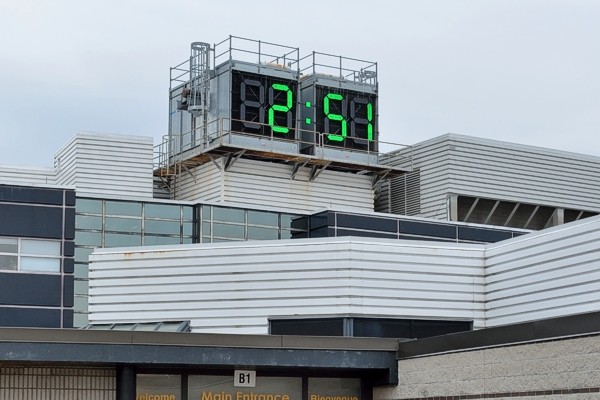

(the accompanying didactic panel)
After a Mural I Painted in Grade Four
2013
HD video, 34 min
Produced by the Koffler Centre of the Arts for the exhibition We’re In The Library, November 2013.
He uses the familiar utopian image of children of varying nationalities holding hands in a circle (usually surrounding a globe) to call into question such problematic yet common societal images.
“For this piece, twenty children enacted this utopian moment in real life, stretching it to an extended period of time. The instructions were simple, they were asked to “hold hands in a circle, smile and think happy thoughts.” Any control over the participants’ reactions was relinquished after that, and a huge spectrum of behavior resulted. This video charts the event minute-by-minute, from the instant their directive was given to the time the original utopic ideal became unrecognizable.”
Other Themes
Sasaki also makes work about Tom Thompson and the Group of Seven.
As well as cultural differences between North America and Japan.
http://www.jonsasaki.com/























You must be logged in to post a comment.